An aura of unattainable perfection surrounds the violins created by Cremonese luthiers, particularly those made by Antonio Stradivari and Giuseppe Guarneri ‘del Gesù.’ For many, the Golden Age of violin making (1550-1750) represents an unsurpassed pinnacle. Almost all of the most acclaimed soloists have played on these historical instruments, and still, no objective study permits to establish their supposed tonal superiority over modern ones. Authentication of old Italian violins does not take the quality of their sound into account, relying instead on other parameters (visual inspection, historical research of the instrument, the dating of the wood, etc.). Correlating their performance with specific attributes is not only important for historical reasons but also to guide further improvements in the construction of violins.
Recently, Fritz and collaborators decided to test whether soloists show a preference for old Italian instruments over modern ones. This experiment did not try to ascertain objective differences in sound quality; its goal was to assess the subjective taste of players. Twenty-one contestants participating in the 8th International Violin Competition of Indianapolis were allowed to try six instruments. Three were modern copies of Guarneri and Stradivari instruments, and three were old violins, including a Guarneri del Gesù (ca. 1740) and two Stradivari (ca. 1700 & ca. 1715). To avoid any bias, they conducted the tests in a double-blind fashion: all participants and the researcher who handed them the violins for testing purposes used welder goggles. To mask any olfactory cues, they placed a dab of scent under the chinrest of every violin.
All tests took place in a hotel room with dry acoustics, similar to the conditions experienced during violin testing in a shop. In one of the sessions, players had one hour to test all six instruments and decide which one they would most like to take home with them. They also had to rank violins as the “best” and “worst” in four categories: range of tone colours, playability, projection, and response. In a second testing condition, soloists were presented with violin pairs, having one minute to play the first violin and another minute to play the second one. Each pairing contained an old violin and a new one, but their identities were concealed to test participants.
The results were striking: the most-preferred violin was new, and the least preferred one was by Stradivari (see Fig.1). Moreover, there was barely any correlation between the age or price tag of a violin and its perceived quality. Based on their playing experience, participants were not able to discriminate between old and new instruments.
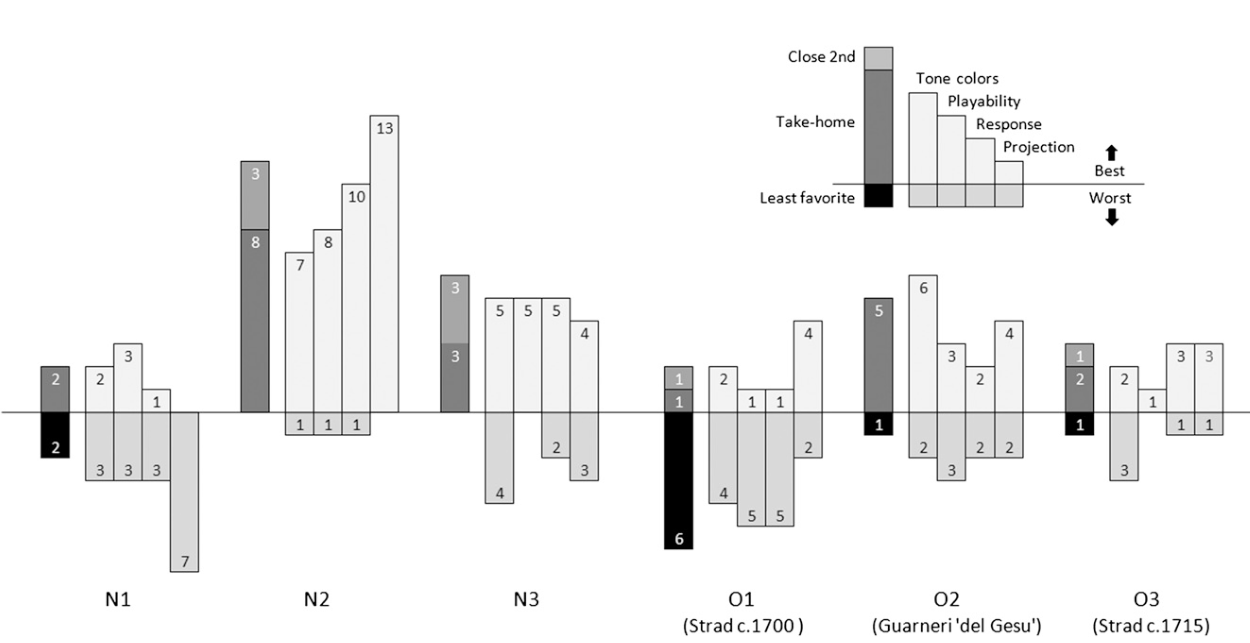
Figure 1. The number of times each violin was selected as a take-home and then best or worst in four categories. The selections for close second and least favourite are also shown (above and below take-home block, respectively). Fritz et al., 2012.
Years later, Fritz and coworkers repeated the test, but on this occasion, twelve instruments (six old and six new) were used, and the new experimental conditions included longer trials in a rehearsal room and a concert hall with capacity for 300 people (Fritz et al., 2014). Still, violin players could not reliably tell whether they were playing on an old Italian instrument or a new one, at better than chance level. Tai questioned these quick-judgement tests on the basis of the duration of auditory short-term memory. He claimed that this memory is too short, decaying in a few seconds. Therefore the trace left by the first playing experience would be too labile to be remembered and compared with the second playing experience. Fritz replied that this seems to contradict quick verdicts during violin testing at repair shops. The debate is open!
Researchers have been trying hard to correlate different attributes of these violins with their tonal quality, pursuing different hypotheses. Let’s have a look at what science can tell us about Stradivarius violins.
Acoustics
The body of a violin is composed of two parallel wooden plates that form the top and bottom of a resonant box. When a string is bowed, the resulting vibrations are transmitted to the soundboard through the bridge, reaching the violin’s body. It is this resonant box that radiates into the surrounding air, making it audible. This phenomenon is called acoustic radiation.
A resonant frequency is the natural frequency of vibration determined by the physical parameters of the vibrating object. It is easier to get an object to vibrate at its resonant frequency, than at any other frequency. The body of a violin behaves like an air cavity resonator. If we push extra air into the cavity and then release it, the pressure inside will drive it out. However, acting like a spring with a mass, it will overshoot, creating a little bit of vacuum inside that will cause air to oscillate in and out of the cavity at the natural frequency.
But how do the different parts of a violin contribute to acoustic radiation? Nia and coworkers studied the effect of the shape of sound holes on the acoustics of string instruments (see Fig. 2-4). Sound-holes are not a mere decoration; they provide a means for air flowing to the exterior from the interior of the violin’s body and hence are good candidates for influencing sound production. Using a combination of X-ray and computer tomography (CT) scans as well as measurements obtained from technical drawings of string instruments from museum collections and books, they generated a computer model that monitors the evolution of sound holes’ design throughout history and their acoustical impact. Researchers obtained sound-hole shapes from contemporary iconography or extant string instruments spanning from the 10th century to 16th-18th centuries.
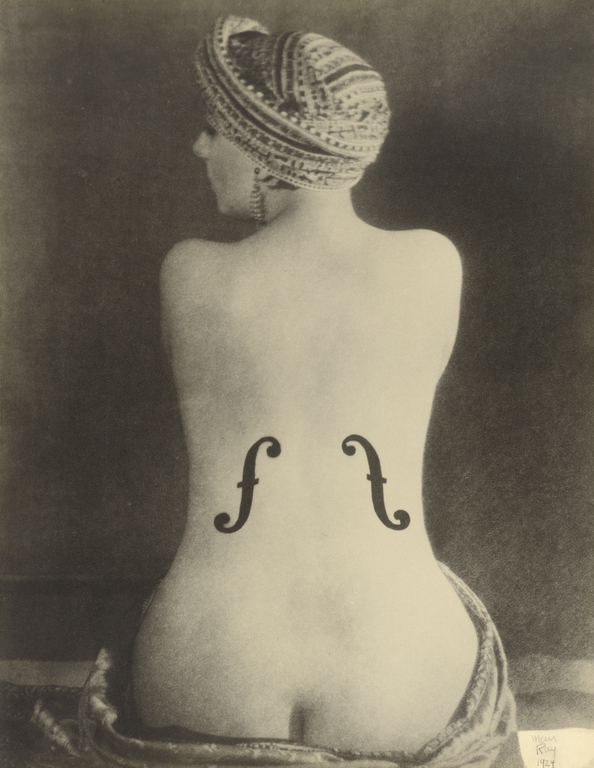
Figure 2. Sound-holes (or f-holes in this case). “Le Violon d’Ingres,” Man Ray, 1924.
They found that airflow at the perimeter rather than the broader surface of sound-holes dominates sound production. As the geometry of sound-holes slowly evolved over centuries from a circular open hole to the slender f-holes of Stradivari and Guarneri, the ratio of inactive surface area to the total sound-hole area was dramatically reduced, basically doubling the power of emitted sound.
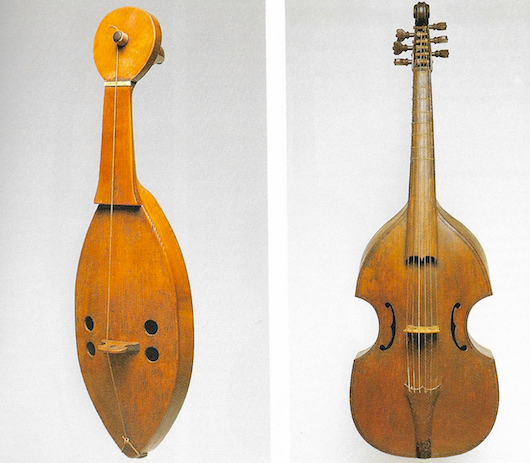
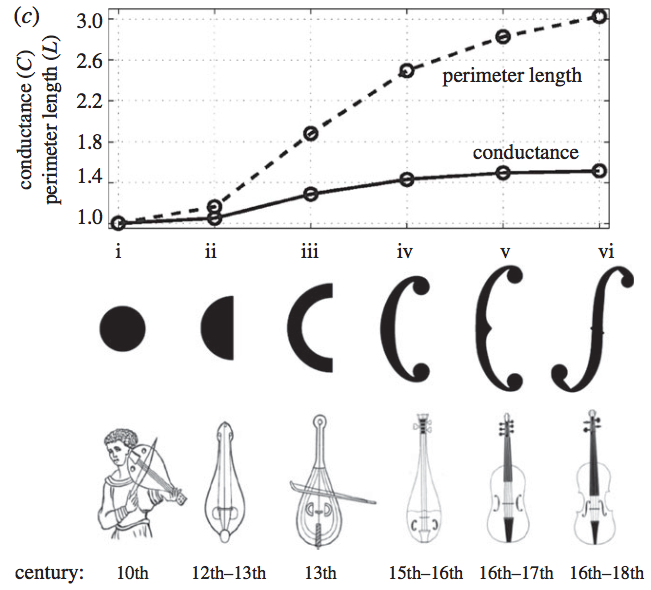
Figure. 3 Acoustic power efficiency grows as sound hole shape evolves over centuries. Top plate: On the left, a gigue reconstructed from a sculpture of Moissac’s cathedral. Right: Small bass viol from the second half of the 16th century (inv. M1327 & M1425, Museum of musical instruments, Brussels). Bottom plate: Conductance (C) and perimeter length (L) for different soundhole shapes. Adapted from Nia et al., 2015.
Based on measurements of 470 Cremonese violins from the workshops of Amati, Stradivari, and Guarneri, in only two centuries f-hole length increased by 30%, producing instruments with 60% higher resonance power.
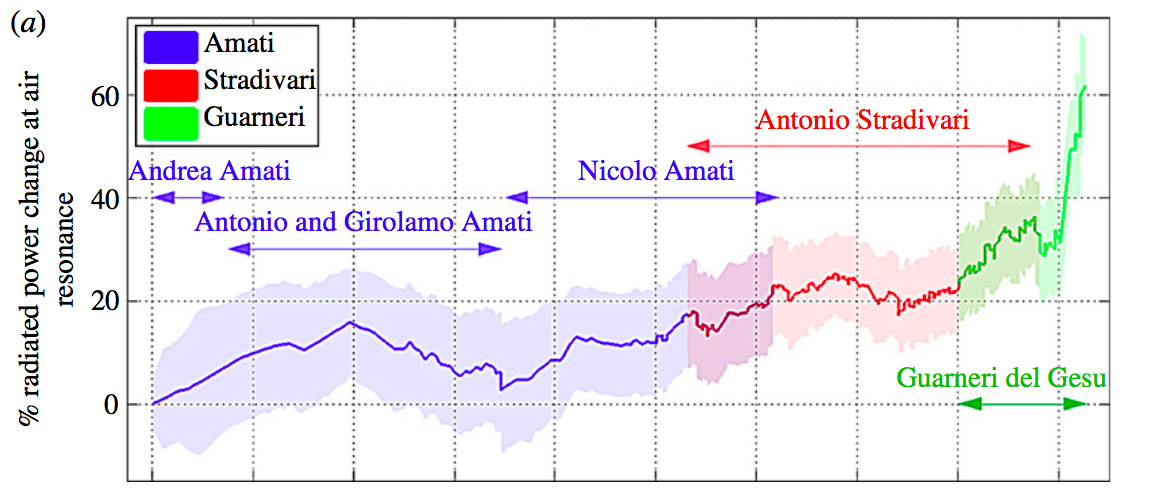
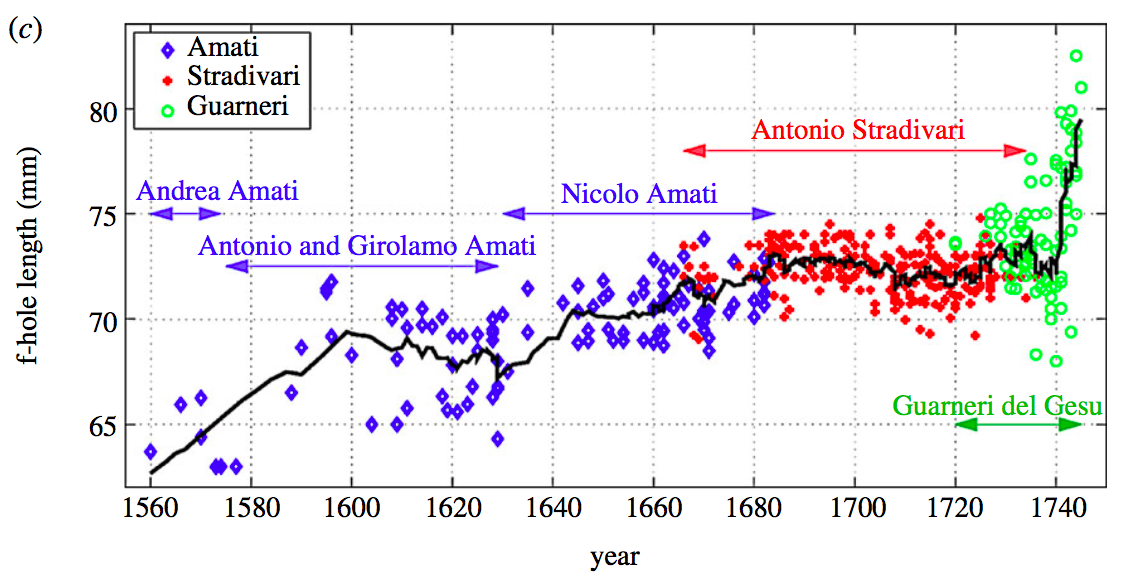
Figure 4. Top graph: Time-series of acoustic power resonance changes during the Golden Age of violin making. Bottom graph: Increase in f-hole length. This data is based on 470 instruments from Amati, Guarneri and Stradivari workshops (from Nia et al., 2015).
Moreover, during the Golden Age of violin making, the upper plates of the violin’s resonance box were kept light, but the lower plate thickness increased. Top plates were thus more responsive to direct forcing at the bridge of the instrument, driving more air through the sound-holes.
The slow drift in design over these two centuries, incompatible with the planned introduction of a radically new pattern of sound-holes, raises an intriguing possibility. This process might have occurred by chance, through the introduction of small mistakes in wood carving leading to violins with a more powerful sound. Analogous to the role played by mutations in the evolution of species, the errors conferring violins with a more robust sound were probably selected for replication within the workshops in Cremona, fixing the new trait in the pool of available violins.
Based on these results, it is interesting to think that the violin’s prominence in 17th-18th centuries might have been a result of its ability to project sound more efficiently, as venue size increased during a shift from courtly circles of performance to public theatres.
Chemistry of wood
Other researchers have concentrated their efforts on analysing the wood used to make old violins. Since vibrations of the front and back plates largely determine violin acoustics, people speculated that Stradivari’s wood possessed unusual properties not found in tonewood used by new makers. Whereas Maple (Acer spp.) was usually preferred for the backplate, ribs, and neck, spruce (Picea spp.) would be the first choice for the top plate. These wood types have superior acoustical and mechanical properties, with minimal loss of energy through internal friction, compared to other woods. For example, spruce cells are light, hollow, and rigid, ideal properties for enhanced resonance.
But wood is far from being homogeneous, and this occurs because the relative proportions of earlywood (thin-walled and less dense cells) and latewood (thick-walled, denser cells) change with different environmental factors such as altitude, sun exposure, and temperature, among others. Using quantitative computer tomography densitometry, Stoel & Boerman measured the wood density of five old Cremonese instruments and compared them with eight modern ones. Computed tomography (CT) scanning is a non-invasive imaging technique that uses X-ray beams to scan an object’s body, creating cross-sectional planes that can be later rendered in 3D using appropriate reconstruction algorithms. Photons that cross the sample are attenuated and counted by a detector.
The results revealed that the density difference between wood grains of early and late growth was significantly smaller in old violins, as compared with new ones. This result would be consistent with a report by Tai and coworkers, which showed evidence of decomposition of hemicellulose in old samples (up to 40%), thereby reducing the density of the wood. Another component of wood is cellulose, which exists in two states. Crystalline, rod-shaped domains are chemically very stable, but they are surrounded by amorphous regions, which are prone to degradation. However, the ratio of crystalline to amorphous cellulose was not significantly different between old and new instruments. These results are challenging to analyse because high-frequency vibrations in wood reduce its internal friction, presumably by rearranging hydrogen bonds and polymer chains. Longer playing time could have gradually altered the ultrastructure of wood fibres, acting in concert with hemicellulose decomposition over time.
Chemistry of the varnish
The cinnabar varnish that characterises Stradivari ‘s violins has long been held responsible for their beautiful tone. Is there anything different, chemically speaking, in Stradivari’s varnish? Nagyvary and collaborators set out to answer this question, using a battery of analytical chemistry techniques. One of these methods, energy-dispersive X-ray spectroscopy (EDS), involves focusing a high energy beam of electrons or protons on the sample. When excited, an electron at rest might be propelled to a higher energetic level, leaving an electron-hole behind. An electron with higher energy can, in turn, fill this hole. When an excited electron relaxes back to the ground state at rest, it releases the energy difference in the form of X-rays. The emission spectrum can be measured and gives invaluable information about the elements present in the sample. Since each element has a unique atomic structure, its presence is associated with a unique pattern of peaks in the emission spectrum, leaving a sort of chemical fingerprint (Fig. 5).

Figure 5. EDS spectra obtained from the ash of Stradivari and Guarneri violins (from Nagyvary et al., 2009).
Subjecting varnish samples from Stradivari and Guarneri violins to this analysis, revealed the presence of unusual chemicals. BaSO, CaF2, borate and ZrSiO4 salts were detected, indicating exposure to some form of chemical treatment. The authors reasoned that luthiers in the 18th century could have treated tonewood with mineral infusions. Soaking the wood for a long time could have removed sap nutrients that facilitate microorganism growth and helped introduce various preservatives such as alum, sodium chloride, or vitriols (sulfates of copper and zinc). Many of these compounds have fungicidal action, and they might have been used by Cremonese luthiers to protect the wood. Additional analytical methods are necessary to unravel the complex interactions between ageing, chemical treatments and high-frequency vibrations and their impact on the acoustic performance of Stradivari violins.
Coda
Highly trained and discerning violinists could not tell old from new, playing on instruments with very different prices (100 fold). A few years ago, researchers convincingly showed that the price tag of wine increases our perception of pleasantness in a blind tasting. Why do we sometimes favour this top-down (based on expectations) over bottom-up processing (based on sensory experience)? We will talk about this issue in another article on this blog.
Meanwhile, we can continue enjoying music played on old violins and enlarge our experience by including modern versions like the 3Dvarius, the first violin created with 3D printing technology. Based on a real Stradivarius violin, its creator is Laurent Bernadac who used stereolithography to prolong a long tradition in violin-making. On sale for € 7000, it is now on the market, awaiting new players.
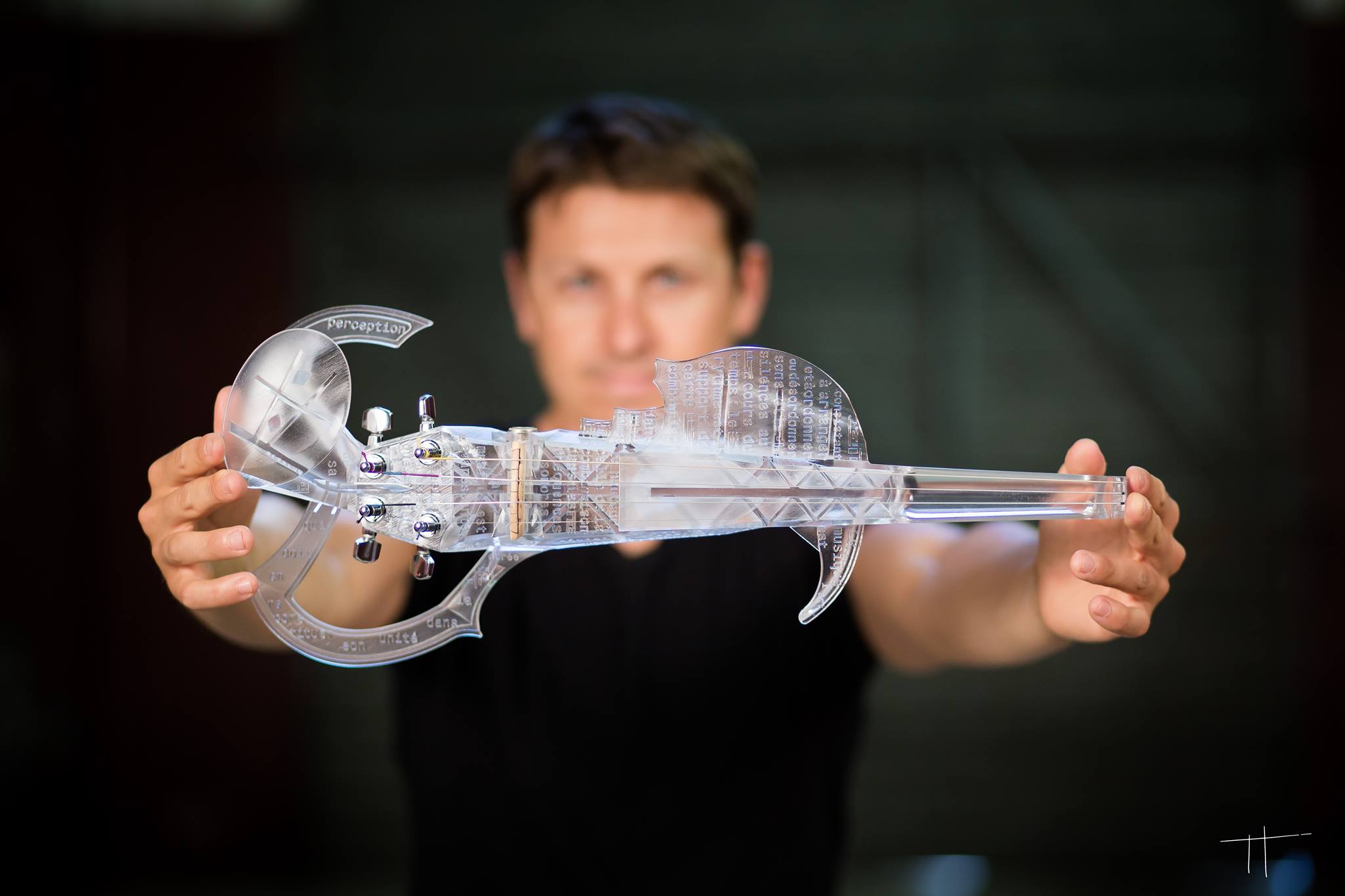
Figure 6. The 3Dvarius, the first violin created with 3D printing techniques.
References
Fritz et al. (2012). Player preferences among new and old violins. PNAS, vol. 109, nr. 3, pp: 760-763.
Fritz et al. (2014). Soloist evaluations of six Old Italian and six new violins. PNAS, vol. 111, nr. 20, pp. 7224-7229.
Fritz et al. (2014). Reply to Tai: On the inability of 10 soloists to tell apart Old Italian and new violins. PNAS, vol. 111, nr. 27 DOI: 10.1073/pnas.1407929111
Tai et al. (2016). Chemical distinctions between Stradivari’s maple and modern tonewood. PNAS, vol. 114, nr. 1, pp. 27-32.
Tai HC (2014). Role of timbre memory in evaluating Stradivari violins. PNAS, vol. 111, nr. 27 DOI: 10.1073/pnas.1407222111
Stoel & Boerman (2008). A comparison of wood density between classical Cremonese and modern violins. PlosOne, vol. 3, issue Nr. 7. DOI:10.1371/ journal.pone.0002554
Nagyvary et al. (2009). Mineral preservatives in the wood of Stradivari and Guarneri. PlosOne, vol. 4, issue Nr. 1. DOI:10.1371/ journal.pone.0004245
Nia et al. (2015). The evolution of air resonance power efficiency in the violin and its ancestors. Proceedings of the Royal Society A. http://dx.doi.org/10.1098/rspa.2014.0905












May 5, 2018
I am extremely impressed with your writing skills as well as with the layout on your weblog.
Is this a paid theme or did you modify it yourself? Either way keep up the excellent quality writing,
it is rare to see a great blog like this one nowadays.
May 7, 2018
Hi there! Thank you very much for your input and the encouragement, I am very glad to know that this blog is of some use! The theme comes from http://www.elegantthemes.com, you might want to have a look, they have plenty of models on sale.
Thanks again and enjoy it!